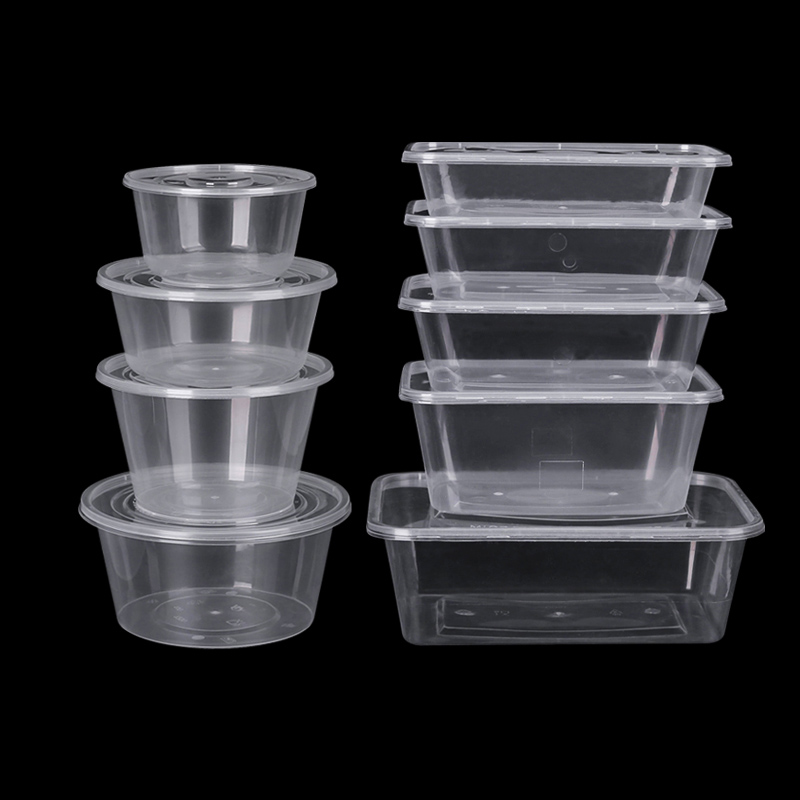
Disposable plastic bowls with lids are everyday essentials in food handling, valued for their convenience and versatility. These containers simplify storing, transporting, and serving food across homes, businesses, and public spaces. This guide explores their design, functionality, applications, and key considerations for users.
Design and Structure
Disposable plastic bowls with lids feature a straightforward yet effective design. The bowls are typically made from rigid plastic, shaped with smooth interiors for easy food removal and slightly tapered sides to enable stacking. This stacking capability saves space during storage, whether in a kitchen cabinet or a commercial warehouse.
The lids are engineered to fit tightly, with a rim that locks onto the bowl’s edge to create a seal. This seal helps prevent leaks, making the bowls suitable for liquids like soups, sauces, or dressings. Many lids have a flat or slightly domed top, allowing them to stack securely when closed, which is useful for transporting multiple portions.
Sizes vary widely, from small 4-ounce bowls for dips and condiments to large 32-ounce options for main dishes or family-sized servings. This range ensures there’s a suitable size for nearly any food item, from individual snacks to bulk storage.
Material Composition
Most disposable plastic bowls with lids are crafted from polypropylene (PP) or polyethylene (PE). PP is heat-resistant, allowing the bowls to hold hot foods up to around 212°F (100°C) without warping. This makes them ideal for serving freshly cooked soups or warm meals. PE, while slightly less heat-resistant, offers flexibility, which helps the lids form a tight seal.
Both materials are food-grade, meeting safety standards for direct contact with edible items. Some manufacturers use recycled plastic in their production, though these still adhere to strict safety guidelines to ensure they’re safe for food use.
Core Functions and Benefits
Leak Prevention: The tight seal of the lids minimizes spills, making them reliable for transporting liquid-based foods. This is especially important for takeout orders, packed lunches, or picnics.
Freshness Retention: By limiting air exposure, the lids help keep food fresh for longer periods. This is beneficial for storing leftovers in refrigerators or keeping prepared meals fresh until serving time.
Visibility: Many bowls are clear, allowing users to quickly identify contents without opening the lid. This saves time when searching through a refrigerator or selecting pre-portioned items.
Durability: The rigid plastic construction resists cracking under normal use, even when holding dense foods like rice, pasta, or salads with heavy dressings.
Applications in Daily Life
Food Service Businesses
Restaurants, cafes, and delis frequently use these bowls for takeout and delivery. They’re perfect for serving salads, noodles, desserts, and side dishes, ensuring that food arrives intact and presentable. The lids also help maintain the temperature of hot or cold items during transit.
Home and Personal Use
In households, these bowls simplify meal prep and storage. They’re ideal for portioning out ingredients, storing leftovers, or packing lunches for school or work. Their disposable nature means no cleanup is needed, saving time for busy families.
Events and Catering
Caterers and event organizers rely on them for buffets, parties, and gatherings. Pre-portioned foods can be set out in sealed bowls, protecting them from contaminants and making it easy for guests to serve themselves. After the event, the bowls can be disposed of, reducing post-event cleanup.
Institutional Settings
Schools, hospitals, and workplaces use these bowls to serve individual meals. They ensure portion control, maintain hygiene, and simplify distribution, making them a practical choice for large-scale food service.
Environmental Considerations
While convenient, disposable plastic bowls with lids contribute to plastic waste. Most are not biodegradable, but many are recyclable if they’re clean and free of food residue. It’s important to check local recycling programs, as some facilities accept PP and PE plastics.
Eco-conscious alternatives, such as bowls made from plant-based materials, are available. These compostable options break down in industrial composting facilities, though they require specific conditions to decompose properly. Reusing the bowls for non-food purposes, like storing small items or organizing supplies, can also extend their lifecycle and reduce waste.
Practical Usage Tips
For hot foods, confirm the bowl is heat-resistant to avoid warping or melting.
Ensure the lid is properly sealed by pressing firmly around the entire rim to prevent leaks.
When storing in the refrigerator, leave a small gap if the food is still warm to allow steam to escape, then reseal once cooled.
Dispose of used bowls responsibly, separating recyclables from general waste where possible.


